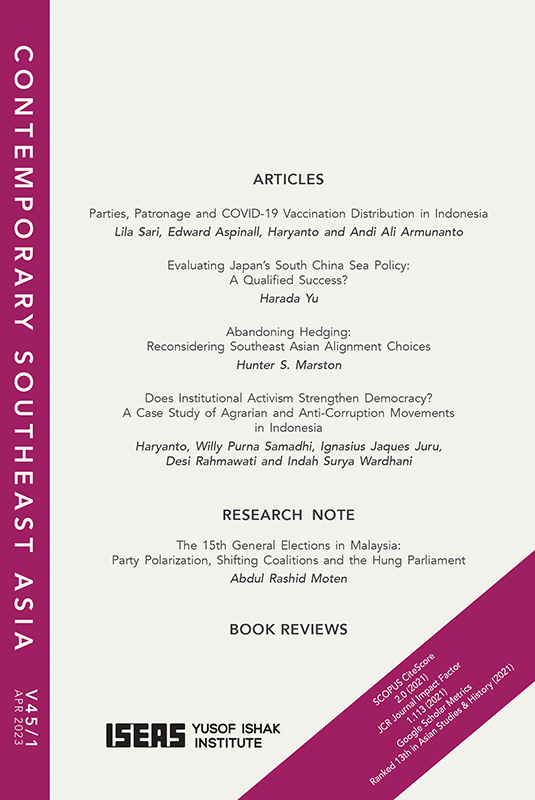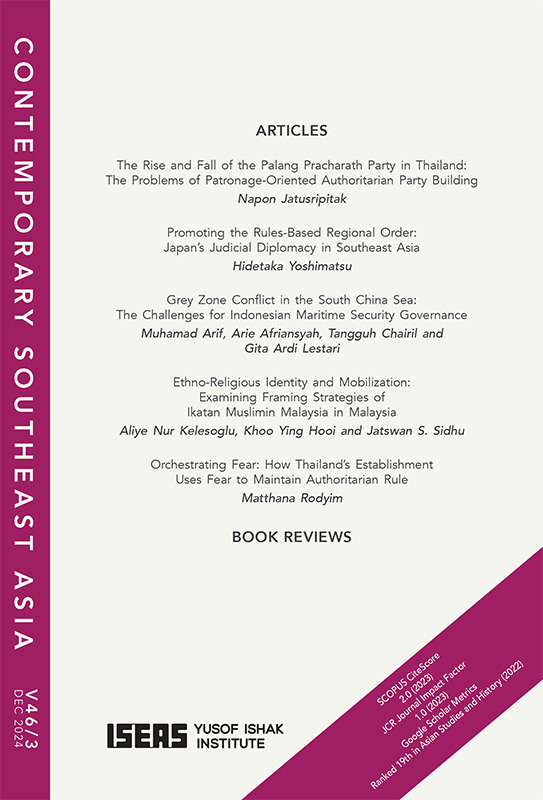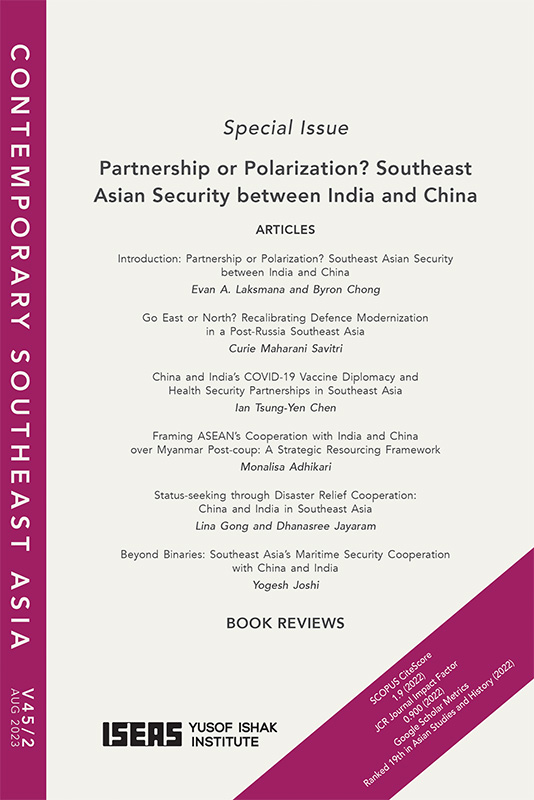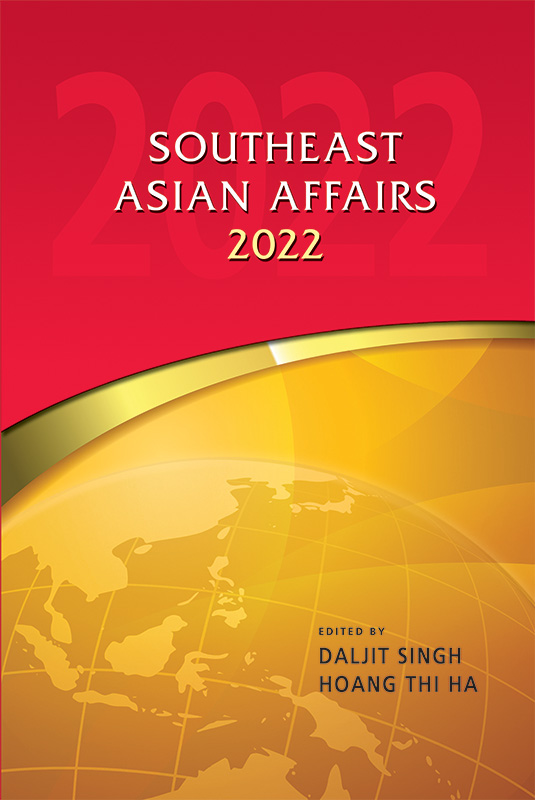Contemporary Southeast Asia Vol. 45/1 (April 2023)

Date of publication:
April 2023
Publisher:
ISEAS – Yusof Ishak Institute
Number of pages:
144
Code:
CS45/1
Soft Cover
ISSN: 0129797X
Contents
-
Contemporary Southeast Asia Vol. 45/1 (April 2023)
[Whole Publication, ISSN: 1793284X] -
Preliminary pages
- ARTICLES
-
1. Parties, Patronage and COVID-19 Vaccination Distribution in Indonesia, by Lila Sari, Edward Aspinall, Haryanto, Andi Ali Armunanto, authors see abstractDuring the COVID-19 pandemic, as Indonesia mobilized to deliver vaccines to the population, an unexpected phenomenon occurred: political parties became directly involved in the vaccine delivery effort. In this article, we draw on online reports and interviews to demonstrate that these campaigns acted as an extension of the patronage politics that dominate the country’s political arena. The involvement of political parties had little effect on the national vaccination effort, as parties delivered a relatively small number of vaccines and often targeted areas that already had high coverage. Instead, parties and politicians used these events to strengthen links with constituents and supporters. We identify three main pathways that allowed political parties to access the vaccines: lobbying by members of the national legislature’s health commission; through local governments; and by direct executive government access to the national Ministry of Health. This “hijacking” of a national policy for clientelistic purposes provides insight into the presence of intra-party coordination of patronage goods but also demonstrates the personalization and fragmentation of patronage distribution highlighted in the existing literature. We conclude by discussing the implications of our findings for the quality of public healthcare and other services in Indonesia.
-
2. Evaluating Japan’s South China Sea Policy: A Qualified Success?, by Harada Yu, author see abstractIn an effort to counteract China’s maritime expansionism, Japan has endeavoured to be a prominent player in the South China Sea dispute over the past decade. While previous studies have emphasized the limitations of Japan’s South China Sea policy, one question still remains: to what extent has Japan’s policy been successful? By utilizing Baldwin’s analytical framework for foreign policy evaluation—which takes into account factors such as stakes, effectiveness and costs—this article argues that Japan’s policy has achieved moderate success. Despite its limitations, Japan’s policy has been relatively successful as it helps to maintain America’s military presence in the region, and creates normative and diplomatic obstacles for China’s activities in the South China Sea without damaging Sino-Japanese relations. Additionally, Japan’s policy helps uphold the rules-based order by strengthening the maritime law enforcement capabilities of selected Southeast Asian states. The costs of the policy to Japan are acceptable, particularly given that it has little impact on the waters surrounding the country. Conversely, the policy imposes increased material, normative and time costs on China. Given China’s uncompromising historical and security position in the South China Sea, the qualified success of Japan’s policy should be acknowledged.
-
3. Abandoning Hedging: Reconsidering Southeast Asian Alignment Choices, by Hunter Marston, author see abstractIn the face of intensifying strategic competition between the United States and China, most Southeast Asian states continue to prefer hedging strategies in an effort to maintain autonomy and flexibility. This involves deepening ties with both superpowers rather than siding with one or the other. Many studies have focused on why and how states hedge, but no scholarly analysis to date has considered why a state would abandon hedging even when it is not facing a direct security threat. While structural realist factors such as external security threats and economic rewards remain significant determinants for alignment decisions, this article demonstrates that internal threats can also compel states to abandon hedging in favour of bandwagoning. The article examines two case studies, Cambodia and Myanmar, to demonstrate how autocratic rulers in those two countries have stopped hedging and opted for closer alignment with Beijing in order to bolster regime security. In both cases, political leaders have prioritized personal interests and regime survival over national interests.
-
4. Does Institutional Activism Strengthen Democracy? A Case Study of Agrarian and Anti-Corruption Movements in Indonesia, by Haryanto, Willy Purna Samadhi, Ignasius Jaques Juru, Desi Rahmawati, Indah Surya Wardhani, authors see abstractThis article discusses institutional activism—the practice in which activists take up formal positions within state institutions in order to advance the cause of their social movement—and whether it can deepen democracy. In this study, democracy refers to popular control, or the extent to which the public can exert control over public affairs. The article contributes to the literature by problematizing the extent to which institutional activists can advance their causes through state channels. It does so by investigating the practice of institutional activism in Indonesia’s agrarian reform and anti-corruption movements. The findings suggest that institutional activists have limited political capacity to transform their movement’s agenda into government policies. They fail to represent the broad and diverse interests of social movements and mobilize popular support, thus rendering institutional activism an inadequate strategy to enhance popular control or strengthen democracy.
- RESEARCH NOTE
-
5. The 15th General Elections in Malaysia: Party Polarization, Shifting Coalitions and the Hung Parliament, by Abdul Rashid Moten, author see abstractMalaysia’s 15th General Election on 19 November 2022 has been widely regarded as the most fiercely contested since the nation’s independence in 1957, with a total of 945 candidates from six coalitions of parties and other factions vying for the 222 seats in parliament. The election resulted in a hung parliament—the first of its kind in Malaysia’s federal history. This outcome demonstrated the lack of institutionalization of coalition politics in the country. All these developments took place in the wake of Malaysia’s historic 14th General Election in May 2018, which marked a major turning point in the country’s politics, ushering in a new era of shifting alliances and ending the long-standing domination of a single coalition. Instability in Malaysia’s political system was evident in the 15th General Election as no party or coalition was able to win a majority of seats. Consequently, parties and coalitions engaged in inter- and intra-coalition bargaining to form a governing coalition. A coalition government was formed but political instability continues.
- BOOK REVIEWS
-
BOOK REVIEW: Mobilizing for Elections: Patronage and Political Machines in Southeast Asia, by Edward Aspinall, Meredith L. Weiss, Allen Hicken and Paul D. Hutchcroft, by Jamie S Davidson, author
-
BOOK REVIEW: In Search of Justice in Thailand’s Deep South: Malay Muslim and Thai Buddhist Women’s Narratives, edited by John Clifford Holt, by Ornanong Husna Benbourenane, author
-
BOOK REVIEW: Dynastic Democracy: Political Families of Thailand, by Yoshinori Nishizaki, by Puli Fuwongcharoen, author
-
BOOK REVIEW: Winning by Process: The State and Neutralization of Ethnic Minorities in Myanmar, by Jacques Bertrand, Alexandre Pelletier and Ardeth Maung Thawnghmung, by Renaud Egreteau, author
-
BOOK REVIEW: Beijing’s Global Media Offensive: China’s Uneven Campaign to Influence Asia and the World, by Joshua Kurlantzick, by Munira Mustaffa, author






